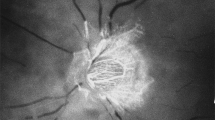Abstract
There appear to be 3 factors in the development of papilloedema - an arterial shunt to the prelaminar tissue and a raised venous pressure in the absence of a raised intraocular pressure, which are passive effects, and an overspill of pial autoregulative vasodilatation which is not passive. In addition the arterial shunt may lead to excessive local autoregulative effects. The engorgement of the fine vessels of the prelaminar tissue, the loss of the spontaneous venous pulse on the disc and the venous overfilling are thought to indicate increased supply and blood flow rather than the reverse. The other general causes of papilloedema can also be explained by the autoregulative mechanism or its breakdown as they involve hypercapnia, tissue anoxia or severe hypertension.
Similar content being viewed by others
References
Alm, A. & A. Bill Ocular and optic nerve blood flow at normal and increased intraocular pressure in monkeys. Exp. Eye Res. 15: 15–29 (1973).
Berens, C., H.T. Smith & L.H. Cornwall Changes in the fundus and retinal artery pressure in increased intracranial pressure. Arch. Neurol. Psychiat. 20: 1151–1171 (1928).
Brégeat, P. L'oedème papillaire. Paris, Masson, 1956.
Ford, F.R. & E.L. Murphy Increased intracranial pressure. Bull. Johns Hopk. Hosp. 64: 369–398 (1939).
Freusberg, O. Halbteilige homonyme Stauungspapille bei partieller Optikusatrophie nach einseitiger Traktusläsion. Klin. Mbl. Augenheilk. 101: 494–507 (1938).
Gafner, F. & H. Goldmann Experimentelle Untersuchen über den Zusammenhang von Augendrucksteigerung und Gesichtsfeldschädigung. Ophthalmologica 130: 357–377 (1955).
Harper, A.M. Autoregulation of cerebral blood flow. J. Neurol. Neurosurg. Psychiat. 29: 389–403 (1966).
Hayreh, S.S. Pathogenesis of oedema of the optic disc (papilloedema). Brit. J. Ophthal. 48: 522–543 (1964).
Hayreh, S.S. Blood supply of the optic nerve head and its role in optic atrophy, glaucoma and oedema of the optic disc. Brit. J. Ophthal. 53: 721–748 (1969).
Hayreh, S.S. & E.S. Perkins The William Mackenzie Centenary Symposium on ‘The ocular circulation in health and disease’. London, Kimpton, 1969, p. 71–86.
Hedges, T.R. Intracranial pressure and papilloedema. Trans. Ophthal. Soc. U.K. 89: 691–723 (1969).
Hedges, T.R. & J.D. Weinstein The hydrostatic mechanism of papilloedema. Trans. Amer. Acad. Ophthal. Otolaryng. 72: 741–750 (1968).
Hollenhorst, R.W., J.H. Svien & C.F. Bensit Unilateral blindness occurring during anesthesia for neurosurgical operations. Arch. Ophthal. 52: 819–830 (1954).
Lassen, N.A. The luxury perfusion syndrome. Lancet 2: 1113–1115 (1966).
Lassen, N.A. J. Olesen, E. Skinhøj, S. Strandgaard Autoregulation of brain circulation in severe arterial hypertension. Brit. med. J. 1: 507–510 (1973).
Leinfelder, P.J. Pathogenesis of papilloedema. Amer. J. Ophthal. 48: 107–110 (1959).
Levatin, P. & R. Raskind Delayed appearance of papilloedema. Canad. J. Ophthal. 8: 451–455 (1973).
Pálbölgyi, R. Regional blood flow in patients with intracranial tumours. J. Neurosurg. 31: 149–163 (1969).
Paton, L. & G. Holmes The pathology of papilloedema. Brain 33: 387–432 (1911).
Primrose, J. Mechanism of production of papilloedema. Brit. J. Ophthal. 48: 19–29 (1964).
Primrose, J. Papilloedema and related eye conditions. In: Handbook of clinical neurology, Vol. XVI, p. 270–300 (1974).
Roper-Hall, K.S. Optic disc oedema in the absence of raised intracranial pressure. Brit. J. Ophthal. 42: 91–98 (1958).
Toyama, T. The retinal blood pressure in choked disc. Jap. J. Ophthal. 3: 216–223 (1959).
Walsh, T.J. J. Garden & B. Gallagher Relationship of retinal venous pulse to intracranial pressure. In: Neuroophthalmology; ed. by Smith Vol. IV., Saint Louis, Mosby (1968), p. 288–292.
Weigelin, E. & A. Lobstein Ophthalmodynamometry. Basel, Karger, 1963.
Wertheimer, P. J. Wertheimer, C. Lapras & A. Morin L'oedème papillaire au cours de traumatismes craniens. Bull. Soc. fr. Ophtal. 76: 275–284 (1963).
Wolff, E. The anatomy of the eye and orbit; 4e ed. London, Lewis, 1954.
Author information
Authors and Affiliations
Additional information
Regional Eye Unit, Oldchurch Hospital, Romford
Rights and permissions
About this article
Cite this article
Primrose, J. Pathogenesis of papilloedema. Doc Ophthalmol 40, 391–408 (1976). https://doi.org/10.1007/BF00155049
Issue Date:
DOI: https://doi.org/10.1007/BF00155049




